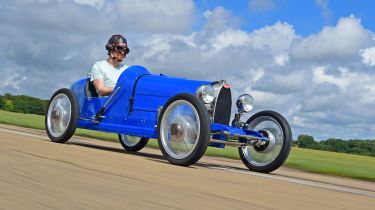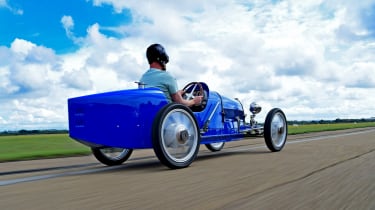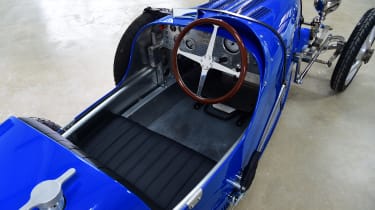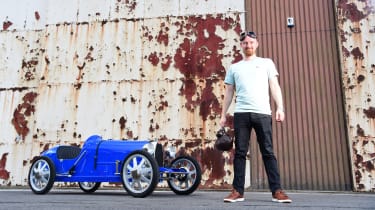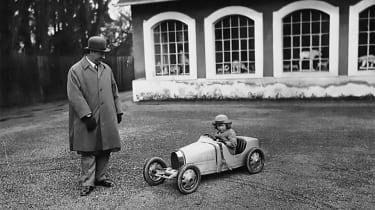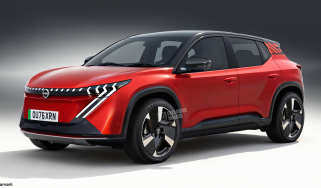We drive the The Little Car Company electric Bugatti Type 35 toy racer
The Little Car Company shrinks Type 35 racer to make fun-size Bugatti Baby II
Remember that classic advert for Werther’s Originals? That cheery old man reminiscing about the very first time his Grandad treated him to a finely wrapped lozenge of that creamy butter candy. “I remember feeling like I must be someone very special,” he chuckles, settling back into his armchair before dishing out the treats to his own grandson.
That’s how Ben Hedley feels. He’s the CEO of the Little Car Company that makes this Bugatti Baby II: a scaled-down, electric-driven replica of the iconic Type 35 racers that dominated 1920s motor racing.
“We see this as a Werther’s Originals car” says Hedley. “It’s something that will be cherished and passed down through generations”. This then, isn’t just a kid’s toy. It’s for big kids, too.
The original Type 35 was a thoroughbred racer, oozing with Ettore Bugatti’s engineering genius. He was obsessed with lightweight components: aluminium wheels reduced unsprung mass, while the front brake drums were cast in the same piece, trimming heft and making brake shoe changes quicker during pit stops. A unique hollow front axle helped to further shed kilos, yet remained sturdy enough to withstand the abuse of endurance racing. The 2.0-litre straight-eight engine’s crankshaft sat on roller bearings and was manufactured to incredibly fine tolerances.
Despite the clever design, success wasn’t immediate. Making its debut at the 1924 French Grand Prix, the best finish from Bugatti’s five factory-backed entries was seventh, 40 minutes behind the winning Alfa Romeo.
A shortage of power was to blame, but that was soon fixed by increasing engine capacity to 2.3 litres and by bolting on a supercharger. Then it became unstoppable. In the hands of Louis Chiron and Albert Divo, among others, the Type 35 scooped five Targa Florio victories and numerous Grand Prix wins, which culminated in an unofficial World Championship title in 1926.
To mark this success, Ettore himself decided to create the “Bébé”: a half-scale electric replica. He built one for his children to navigate his chateau’s grounds, but it proved so popular that several hundred were eventually made. They featured a 12-volt battery and did 12mph.
The Baby Bugatti II follows a similar principle. With official licence from Bugatti, the Little Car Company laser scanned every individual component of one of the very first 1924 Type 35s created, and painstakingly made each component to three-quarter scale. Hedley assembled a team that features former Dyson, McLaren and TVR employees. Bugatti’s test driver and Le Mans 24 Hours legend Andy Wallace was also on hand to offer feedback during development (and, as an upcoming interview on the Auto Express YouTube channel will show, he enjoyed every second of it). It is no ordinary toy.
This all becomes clear on our encounter at Bicester Heritage. Wherever you look, the finish is astounding. The hollow axle remains, the eight-spoke aluminium wheels are perfect reproductions of the originals and wrapped in skinny Michelin tyres. The suspension geometry is near-identical, even down to the comical positive front camber. The Bugatti emblem is crafted from 50 grammes of solid silver.
In a bid to make the car as efficient as possible, the Little Car Company developed its own electric motor (complete with regenerative braking system), which is mounted at the rear of the car and drives the back wheels through a limited-slip differential. In the nose, there’s a lithium-ion battery pack. Charging is possible by either removing the battery completely or, in a beautifully elegant solution, via a small plug beneath what would usually be the fuel filler screw cap.
Where changes needed to be made from the original, Hedley and his team have added some neat touches. The turned aluminium dash features custom Bugatti gauges, but in place of the usual tacho, oil pressure and fuel gauges, there’s a speedometer, charge indicator and a Chiron-esque power gauge. That’s not the only thing it shares with the latest hypercar, either: the Baby II uses the Chiron’s pedal design, too.
There are three specs. The entry-level model comes with a composite body and a 5.4bhp motor. The 1.4kWh battery is good for a 15.5-mile range – you can thank the circa-230kg weight for that. Next comes the Vitesse. Its battery is twice as large as the base car’s (and therefore doubles the range to 31 miles), power climbs to 13.4bhp, and the body is formed from carbon fibre.
The car pictured in stunning French Racing Blue (one of 21 body colours available) is the Pur Sang. The drivetrain is the same as that of the Vitesse, but the shell is hand-beaten in aluminum using the same processes as the original Type 35. It’s as beautiful as the 200-hour process suggests.
Those top two models get another Chiron feature that adds to the childlike fun: the Speed Key. In standard form, the Baby is limited to 30mph (a lower setting lets you cap the top speed to 12mph if you don’t quite trust the kids, or indeed yourself) but turn the key into the dash, and you have access to a heady 42mph.
Access is easy thanks to a quick-release kit on a Nardi wooden steering wheel (both bespoke to the car, naturally). Settle on to the seat, and the tiny size – and the lack of windscreen or doors – mean much of your torso is exposed.
The bench is fixed, but the pedals are adjustable. However, in order to make space for the steering column, they’re offset to the opposite side of the footwell. So the natural driving position is to place yourself in the middle of the bench, pedals to the left of you, wheel to the right. The contortion somehow just adds to the charm.
Turn the gorgeous key (aluminium, naturally) and the needles each swoop around their respective gauges. Twisting a kill switch-shaped handle clockwise selects ‘D’, then drop the outboard handbrake lever and away you go.
The initial throttle travel is very smooth, making it a perfectly amiable thing in which to potter about at a jogging pace. The steering is light, and its gearing slow. The ride is hard at the back, the bouncy sensation heightened by the fact that you’re perched directly above the rear axle.
Then as we peel onto the Bicester test track and tease the throttle for the first time, the Baby makes us grin like idiots, and we stay that way for the rest of the day. That delicate throttle response becomes so much sharper further along the travel, and with instant torque from the electric motor combined with that tiny mass, it leaps forward with puppy-like enthusiasm. And if the speed does get out of hand, the drum brakes are more than up to the task, even if the unassisted pedal needs a firm shove.
But the real fun happens in the corners. This is a car with the footprint, responsiveness and agility of a kart, and the mix of a lofty seating position and skinny tyres makes every clipped apex feel so much more heroic.
Chuck it into a corner, and those Michelins cling on gamely. That’s more than can be said for one’s buttocks, which are flung into the outer edge of the cockpit as centrifugal forces overwhelm friction on the soft leather bench. The optional sports pack, which will add extra seat bolstering, looks like an option well worth choosing. There’s also a Touring Pack that adds indicators and mudguards, at which point the Baby is barely a set of number plates away from gaining type approval for a cruise through London.
Having failed to appreciate how fast we were going the first time around (there’s little time to stare at the clocks in between all of the childish giggling) there’s time for just one more lap. A top-speed run is in order. Take a wide line into a tightening right-hander, feed the power in hard and early to get the best possible exit onto the back straight. Right foot pinned against the bulkhead, duck down behind the screen to reduce drag and… the Baby butts against a limiter at an indicated 42mph. Not quite evoking the great victories of Chiron and Divo, but the closest we’re ever likely to feel.
And what is the price for all this joy? Well the entry-level model starts from £27,000 before taxes. Including VAT, the Pur Sang costs £63,600. Or to put it another way, roughly the same as 8.6 metric tonnes of Werther’s Originals, at current supermarket prices. Not cheap compared with, say, a Scalextric set, but something of a bargain compared to the seven-figure sums full-size Type 35s fetch at auction.
Deposits have been taken for the vast majority of the 500-strong production run already. Many are from existing Bugatti owners, and Hedley has been encouraged by the feedback. “We took our car to the Bugatti owners’ club, which is normally against anything that isn’t old and leaking oil. But the feedback was amazing, which was great to see.”
We can understand why. After our encounter with it, it seems like little else on four wheels (or even a pack of sweets from your grandad) will make you smile so much.
Find a car with the experts

